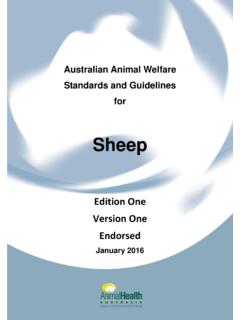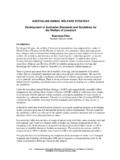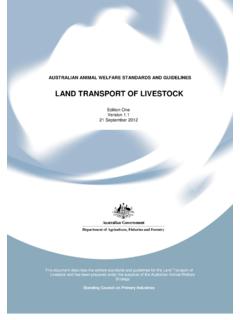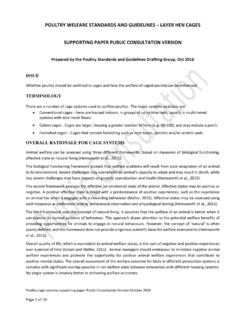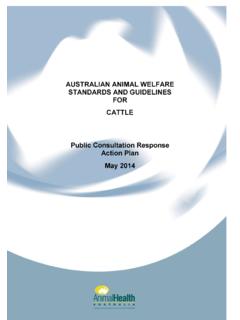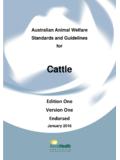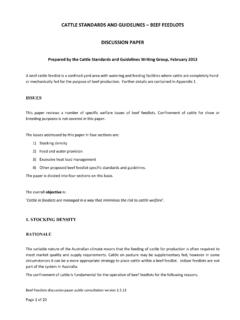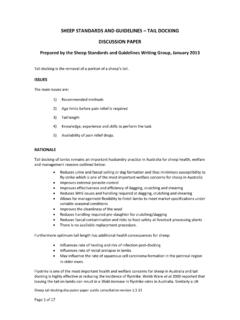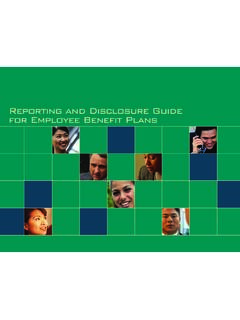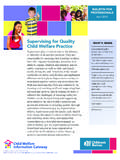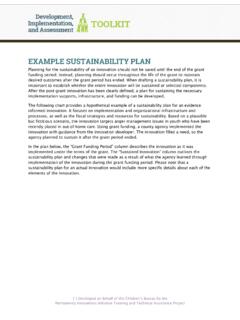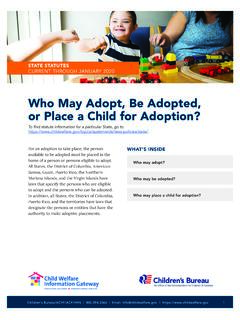Transcription of Australian Animal Welfare Standards and Guidelines for
1 Australian Animal Welfare Standards and Guidelines for Cattle Edition One Version One Endorsed January 2016. This document forms part of the Australian Animal Welfare Standards and Guidelines for the Welfare of Animals. This document will be reviewed regularly. Suggestions and recommendations for amendments should be forwarded to: Animal Health Australia Manager, Veterinary Services Suite 15, 26 28 Napier Close Deakin ACT 2600. Tel: 02 6232 5522; Fax: 02 6232 5511. email: Approved citation: Australian Animal Welfare Standards and Guidelines for Cattle. Animal Health Australia (AHA) 2014. Publication record: Edition 1. Version: January 2016 Endorsed. Available on the internet at Commonwealth of Australia and each of its states and territories 2013. ISBN 978-1-921958-11-3 (electronic version). This work is copyright and, apart from any use as permitted under the Copyright Act 1968, no part may be reproduced without written permission from the publishers, the Australian Government Department of Agriculture, and Animal Health Australia, acting on behalf of the pre-existing Standing Council on Primary Industries (SCoPI).
2 Requests and inquiries concerning reproduction and rights should be addressed to Animal Health Australia (see above). The publishers give no warranty that the information contained in the manual is correct or complete, and shall not be liable for any loss, howsoever caused, whether due to negligence or other circumstances, arising from use of or reliance on this code. Page 2 of 39. C o n t e n ts Contents .. 3. Preface .. 5. Introduction .. 6. Purpose .. 6. Scope 6. Development process .. 7. Interpretation .. 7. Principles for cattle Welfare .. 8. 1 Responsibilities .. 10. Standards ..10. Guidelines ..10. 2 Feed and water .. 11. Standards ..11. Guidelines ..11. 3 Risk management of extreme weather, natural disasters, disease, injury and predation .. 13. Standards ..13. Guidelines ..13. 4 Facilities and equipment .. 15. Standards ..15. Guidelines ..15. 5 Handling and management .. 17. Standards ..17. Guidelines ..18. 6 Castration, dehorning and spaying .. 21. Standards .
3 21. Guidelines ..22. Page 3 of 39. 7 Breeding management .. 24. Standards ..24. Guidelines ..24. 8 Calf-rearing systems .. 26. Standards ..26. Guidelines ..26. 9 Dairy management .. 28. Standards ..28. Guidelines ..28. 10 Beef feedlots .. 29. Objective ..29. Standards ..29. Guidelines ..29. 11 Humane killing .. 32. Standards ..32. Guidelines ..32. 36. Page 4 of 39. Preface The Australian Animal Welfare Standards and Guidelines for Cattle are an important component of the pre-existing Australian Animal Welfare Strategy (AAWS) a previous Australian Government initiative that guides the development of new, nationally consistent policies to enhance Animal Welfare arrangements in all Australian states and territories. The development process is supported and funded by all Governments, Australian Dairy Farmers, Australian Lot Feeders Association and Cattle Council of Australia. The Standards provide a basis for developing and implementing consistent legislation and enforcement across Australia, and provide guidance for all people responsible for cattle.
4 They are based on current scientific knowledge, recommended industry practice and community expectations. The development of these Standards is an important project in a comprehensive program under the AAWS to develop Standards and Guidelines for all commercial livestock species and at all points along the production supply chain. The Standards were developed in consultation with state and territory governments, livestock industry organisations, Animal Welfare groups and the general public under the auspices of the Animal Welfare Committee. The Standards were drafted by a small writing group comprising researchers, government and industry representatives, supported by a widely representative reference group and managed by Animal Health Australia. An important part of the process is the preparation of a regulation impact statement to assess the proposed Standards and evaluate the costs resulting from changes to existing requirements. An extensive consultation process was undertaken, with the final public consultation highlighting ethical and practical issues, which led to the development of more robust Standards .
5 The reference group carefully considered the views and comments of all stakeholders in developing the final Standards and Guidelines for recommendation to Animal Welfare Committee. These Standards and Guidelines will replace the following model code of practice: Model Codes of Practice for the Welfare of Animals: Cattle, 2nd edition, PISC Report 85, CSIRO Publishing, 2004. The preparation of these Standards represents a significant investment by all parties, especially members of the writing and reference groups. Their efforts are gratefully acknowledged by Animal Health Australia. Page 5 of 39. Introduction Purpose The purpose of this document is to state Standards and Guidelines for the Welfare of all cattle in Australia. The document informs all those with responsibilities for the care and management of cattle. The Standards provide the basis for developing and implementing consistent legislation and enforcement across Australia, and direction for people responsible for cattle.
6 They reflect available scientific knowledge, current practice and community expectations. The cattle Standards and Guidelines may be reflected in the industry-based quality-assurance programs that may include cattle Welfare provisions. In May 2009, primary industries ministers took the position that Guidelines , regardless of their purpose in existing codes and the new Standards and Guidelines documents, will not be regulated. In particular agreement was reached that: All future revisions of Model Codes and Australian Standards and Guidelines '. documents must provide a number of: a. clear essential requirements ( Standards ') for Animal Welfare that can be verified and are transferable into legislation for effective regulation, and b. Guidelines , to be produced concurrently with the Standards but not enforced in legislation, to be considered by industry for incorporation into national industry QA along with the Standards . This document has been prepared as part of the pre-existing Australian Animal Welfare Strategy.
7 It is part of a series of Standards and Guidelines , each of which brings together Welfare Standards and Guidelines for a particular species in this case, cattle. Scope The Standards will apply to all cattle-farming enterprises in Australia. Cattle' includes a single bovine Animal . The Standards apply to all those responsible for the care and management of cattle. These Standards and Guidelines should be considered in conjunction with other requirements for livestock, and related Commonwealth, state and territory legislation, including: for farming enterprises model codes of practice or Standards and Guidelines for livestock species, saleyards, livestock processing (slaughter) establishments and the Australian Standards for the Export of Livestock for transport the Australian Animal Welfare Standards and Guidelines Land Transport of Livestock, Australian Standards for the Export of Livestock, livestock health and biosecurity requirements, and regulated livestock loading schemes and driver regulations Page 6 of 39.
8 For research and teaching purposes Australian Code for the Care and Use of Animals for Scientific Purposes, 8th edition, 2013. Where legislation requires a higher standard than these Standards , the higher standard will apply. Where there is a conflict with another standard in meeting the livestock Welfare Standards , the Welfare of livestock must be the first consideration unless there is a work health and safety requirement. Cruelty and unacceptable Animal Welfare practices can be prosecuted under cruelty and aggravated cruelty offence clauses in Animal Welfare legislation. For example, cattle must not be allowed to die from lack of feed or water'. Advice or assistance with Welfare management and disease control is available from state and territory departments of agriculture, locally based private consultants or veterinarians, as appropriate. These Australian Standards and Guidelines do not endeavour to describe best practice'. because it is often too difficult to reflect known regional variation.
9 There are other industry and government documents to better communicate these industry practices that also consider regional variations. Development process Each document in the series of Australian Animal Welfare Standards and Guidelines is produced following the same overall process. Production of the document is undertaken by a writing group and guided by a reference group that includes appropriate representation from industry, government and nongovernment organisations. Standards are based on references identified through a review of relevant scientific literature, commissioned by the writing group, a process that helps to ensure that the Standards are scientifically valid. A regulation impact statement (RIS) is also prepared for the Standards in the document. Through a public consultation process, the community, industry, government and any other relevant stakeholders are given opportunities to comment on drafts of the Standards and Guidelines document, and the RIS.
10 Final documents are made available in print and on the internet at and The final documents also provided to state and territory jurisdictions and industry bodies, for referencing in relevant legislation and to be available for incorporation into industry quality- assurance programs. Interpretation Each numbered section of the document covers a particular topic (water and feed, etc.) and contains the following information: Animal Welfare objective the intended outcome(s) for each section of the Standards and Guidelines . Standards the Animal Welfare requirements designated in this document ( the requirements that must be met under law for livestock Welfare purposes) The Standards are intended to be clear, essential and verifiable statements. However, not all issues are able to be well defined by scientific research or are able to be Page 7 of 39. quantified. Science cannot always provide an objective or precise assessment of an Animal 's Welfare and, consequently, where appropriate science is not available, the Standards reflect a value judgement that has to be made for some circumstances.
